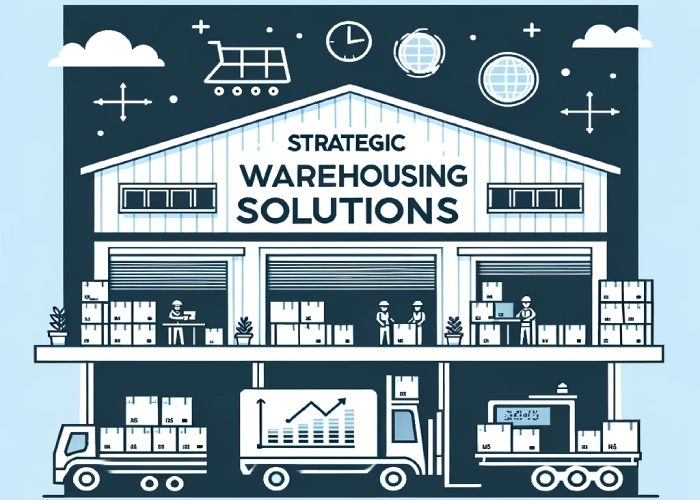In today’s fast-paced market, companies are continuously seeking innovative ways to streamline their operations and enhance profitability. Strategic Warehousing Solutions play a critical role in this transformation. A well-structured warehousing strategy can significantly boost efficiency, reduce operational costs, and improve customer satisfaction. With the rise of e-commerce and shifting consumer expectations, businesses must adapt and optimize their warehousing logistics to stay competitive.
Table of Contents
Smart Warehousing Strategies

Businesses embracing Smart Warehousing Strategies leverage technology to optimize inventory management and maximize available space. Advanced automation tools and inventory management software enable businesses to track their products in real time, ensuring that stock levels are always accurate. This level of oversight not only reduces errors but also improves the speed of order fulfillment.
Case Study: Amazon’s Robotics
Amazon is a prime example of a company that has revolutionized its warehousing operations through technology. By integrating robotics into its fulfillment centers, Amazon has experienced a 20% increase in warehouse efficiency. This significant improvement comes from automating picking and packing processes, which minimizes the time taken to fulfill an order. In 2016, Amazon reported that these strategies allowed it to ship more than 1.5 billion items worldwide during the holiday season alone, showcasing the efficacy of Strategic Warehousing Solutions in a highly competitive retail environment.
Strategic Storage Solutions
Strategic Storage Solutions are crucial for managing space efficiently in warehouses. Businesses must analyze their storage needs and choose the right type of facility to fit these specific requirements. For example, a company focusing on seasonal retail goods may require temporary storage solutions, while e-commerce companies may need other, more permanent options.
Types of Warehouses
Understanding the various types of warehouses can help businesses make informed decisions:
|
Type of Warehouse |
Description |
|
Facilities that offer storage for multiple businesses on a short-term or long-term basis. |
|
|
Private Warehousing |
Managed and utilized solely by one organization for its own purposes. |
|
Distribution Centers |
Focused on the redistribution of goods to retailers or directly to consumers. |
|
Climate-Controlled Warehouses |
Designed to store products sensitive to temperature and humidity. |
|
Automated Warehouses |
Utilize technology and robotics for storage and retrieval processes. |
By selecting the appropriate type of warehouse, companies can optimize their inventory levels, reduce waste, and enhance overall performance.
Canada 3PL: Navigating Third-Party Logistics

As businesses expand their operations, many turn to Canada 3PL providers for specialized support. Third-party logistics (3PL) companies offer comprehensive warehousing and fulfillment services in Canada, enabling businesses to focus on core activities. By implementing Strategic Warehousing Solutions, these services can significantly reduce operational complexities, allowing companies to respond more dynamically to market changes and enhance their overall efficiency.
3PL Warehouse Services in Canada
A prime example of effective 3PL Warehouse Services in Canada is DelGate. They provide an integrated platform combining warehousing and fulfillment technology solutions to streamline operations for online businesses. By implementing Strategic Warehousing Solutions and with multiple fulfillment centers across Canada, they ensure quicker delivery times and reduced shipping costs. Companies like DelGate enable smaller e-commerce businesses to compete with larger retailers by providing access to the same level of logistics capabilities.
Fulfillment Services in Canada
For businesses looking to enhance customer experience, the right fulfillment services in Canada are essential. Efficient order processing, packaging, and shipping significantly affect customer satisfaction. Companies like Shopify offer integrated logistical support, managing inventory and facilitating quicker delivery options.
This service, known for its effectiveness, empowers businesses to provide a seamless shopping experience, which is increasingly critical in the age of e-commerce. Furthermore, leveraging 3PL fulfillment in Canada allows businesses to utilize Strategic Warehousing Solutions that optimize their logistics, ensuring that customer needs are met promptly and efficiently.
Fulfillment Technology Solutions
The integration of fulfillment technology solutions is crucial for improving accuracy and efficiency in supply chain management. Real-time tracking systems allow businesses and customers to monitor order status, reducing anxiety associated with uncertain delivery timelines. Tools like RFID and barcode scanning provide accurate inventory counts and can lead to significant savings.
In a study conducted by the Supply Chain Management Review, companies that invested in advanced fulfillment technologies and Strategic Warehousing Solutions saw a marked increase in operational efficiency—approximately 30%. This statistic underscores the necessity of investing in modern solutions to stay competitive.
Fastest Shipping in Canada
The demand for the fastest shipping in Canada has prompted many companies to optimize their logistics networks with Strategic Warehousing Solutions. For instance, DelGate has invested in technological enhancements to improve its delivery capabilities, resulting in a 25% reduction in order delivery times. Similarly, private logistics companies such as FedEx and UPS also offer expedited shipping solutions tailored to meet the needs of businesses looking to enhance customer satisfaction and loyalty.
Chart: Impact of Efficient Logistics
|
Logistics Factor |
Impact on Business |
|
Reduced Shipping Times |
30% increase in customer satisfaction |
|
Improved Inventory Management |
20% reduction in operational costs |
|
Enhanced Order Accuracy |
15% increase in repeat business |
This data illustrates how efficient logistics not only improve customer experiences but also contribute to sustained business growth.
Reliable Warehouse Facilities
Investing in Reliable Warehouse Facilities is crucial for any business’s growth strategy. Choosing a facility that guarantees security, environmental control, and accessibility can spell significant advantages. This potential includes enhanced inventory management and the ability to pivot quickly to meet changing market demands.
Public Warehousing in Canada
Public Warehousing in Canada has become an attractive option for small to medium-sized businesses seeking Strategic Warehousing Solutions. These facilities offer short-term contractual options, making them ideal for companies facing fluctuating demand or those testing new markets without lengthy commitments. A common example includes companies like C.H. Robinson, which provides flexible storage solutions that can adapt to seasonal variations effectively.
The Role of Third-Party Warehouse Services

Engaging third-party warehouse services allows companies to reduce overhead costs, enhance flexibility, and scale operations based on demand fluctuations. By leveraging the expertise of 3PL providers, businesses can benefit from efficiencies that might be challenging to achieve independently.
For example, a clothing retailer may partner with a 3PL provider to manage seasonal inventory through Strategic Warehousing Solutions, utilizing automated sorting and packing systems. This collaboration can lead to improved order processing times and higher retention rates among customers.
Conclusion
In conclusion, Strategic Warehousing Solutions empower businesses to optimize their supply chains effectively. Whether through smart warehousing strategies, public warehousing options, or utilizing 3PL services, companies can enhance operational efficiency. Embracing innovative warehousing solutions is essential as global trade and e-commerce evolve. As logistics strategies continue to adapt, those who invest in effective warehousing systems will find themselves better positioned to meet the demands of the future marketplace.





